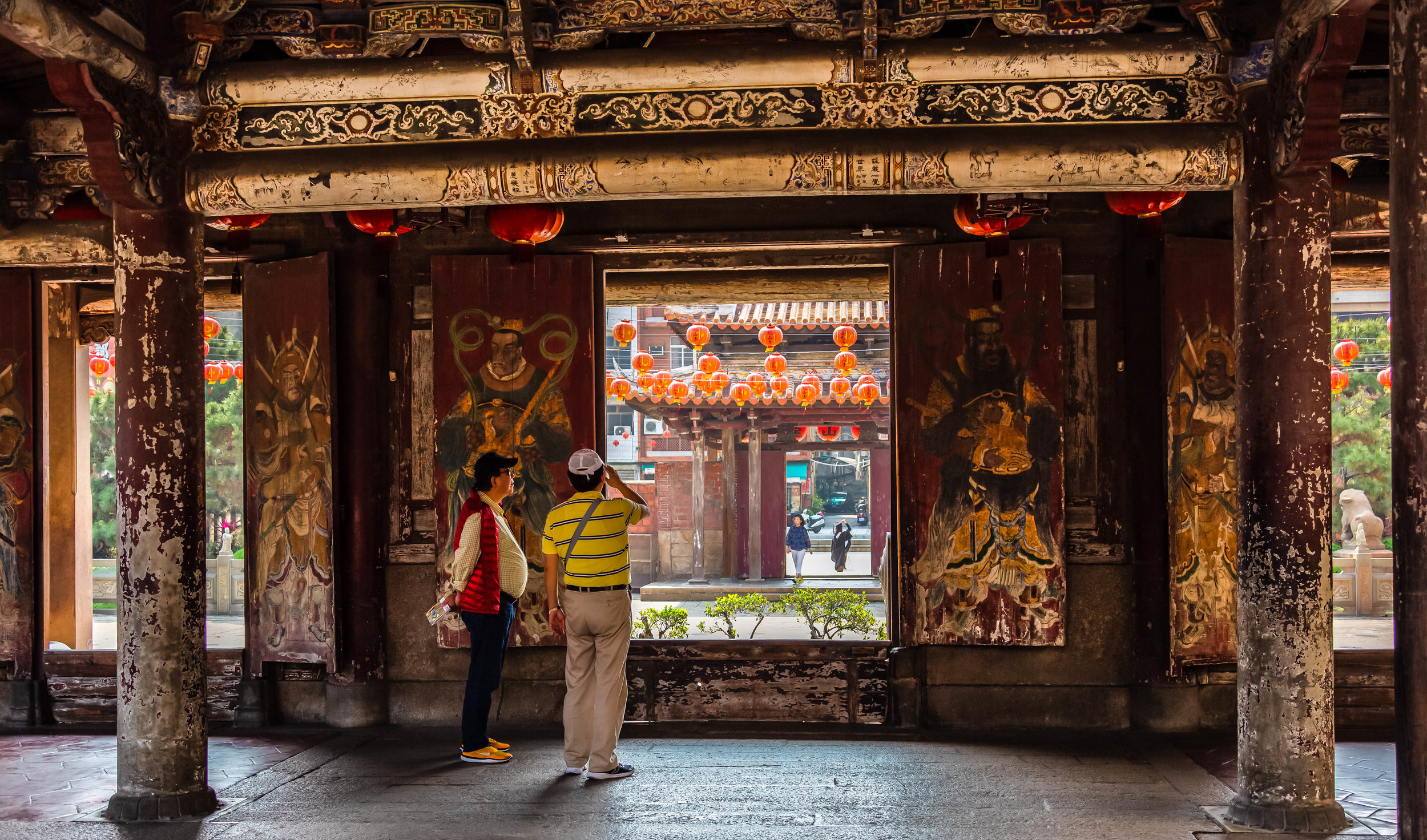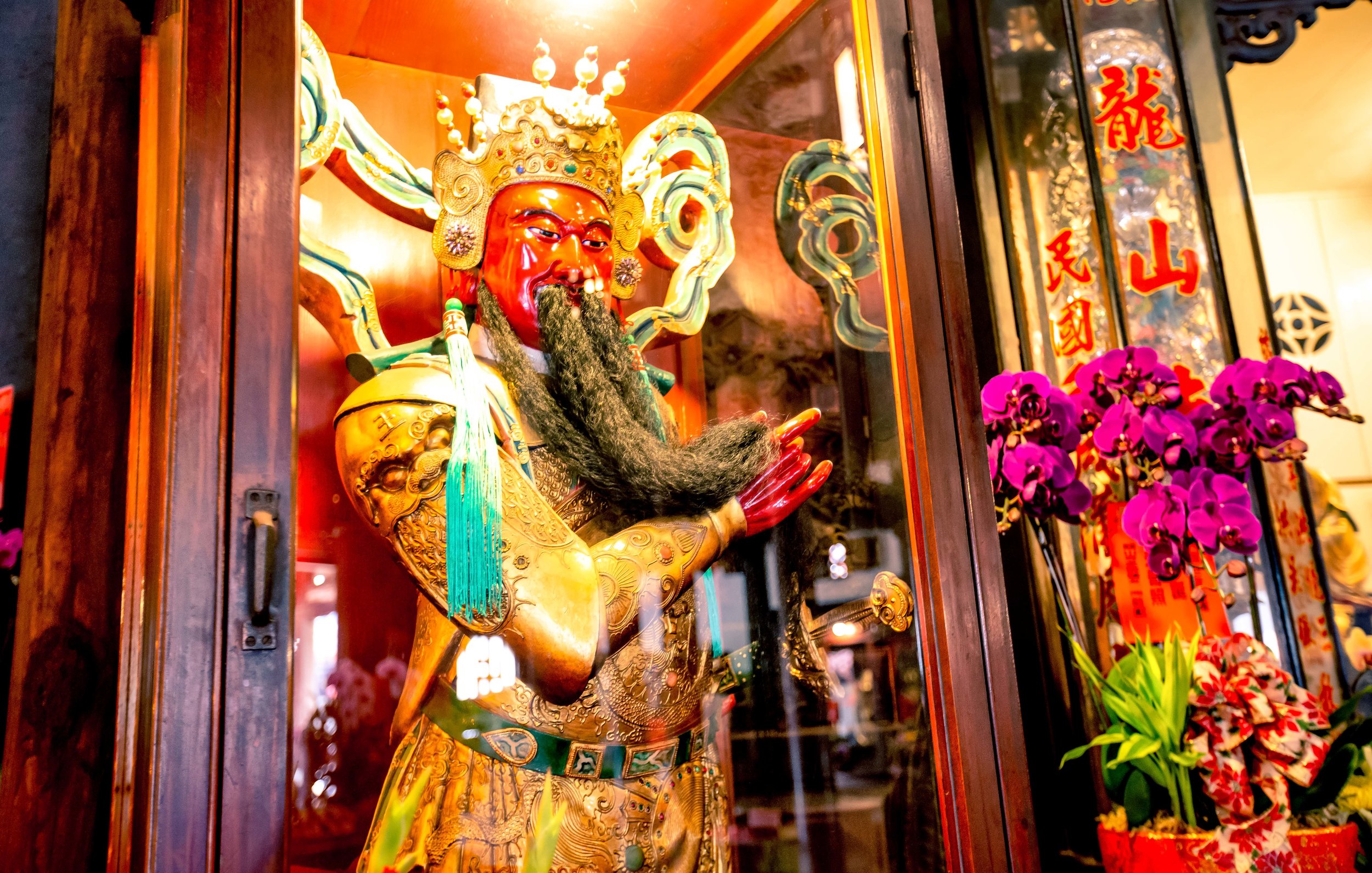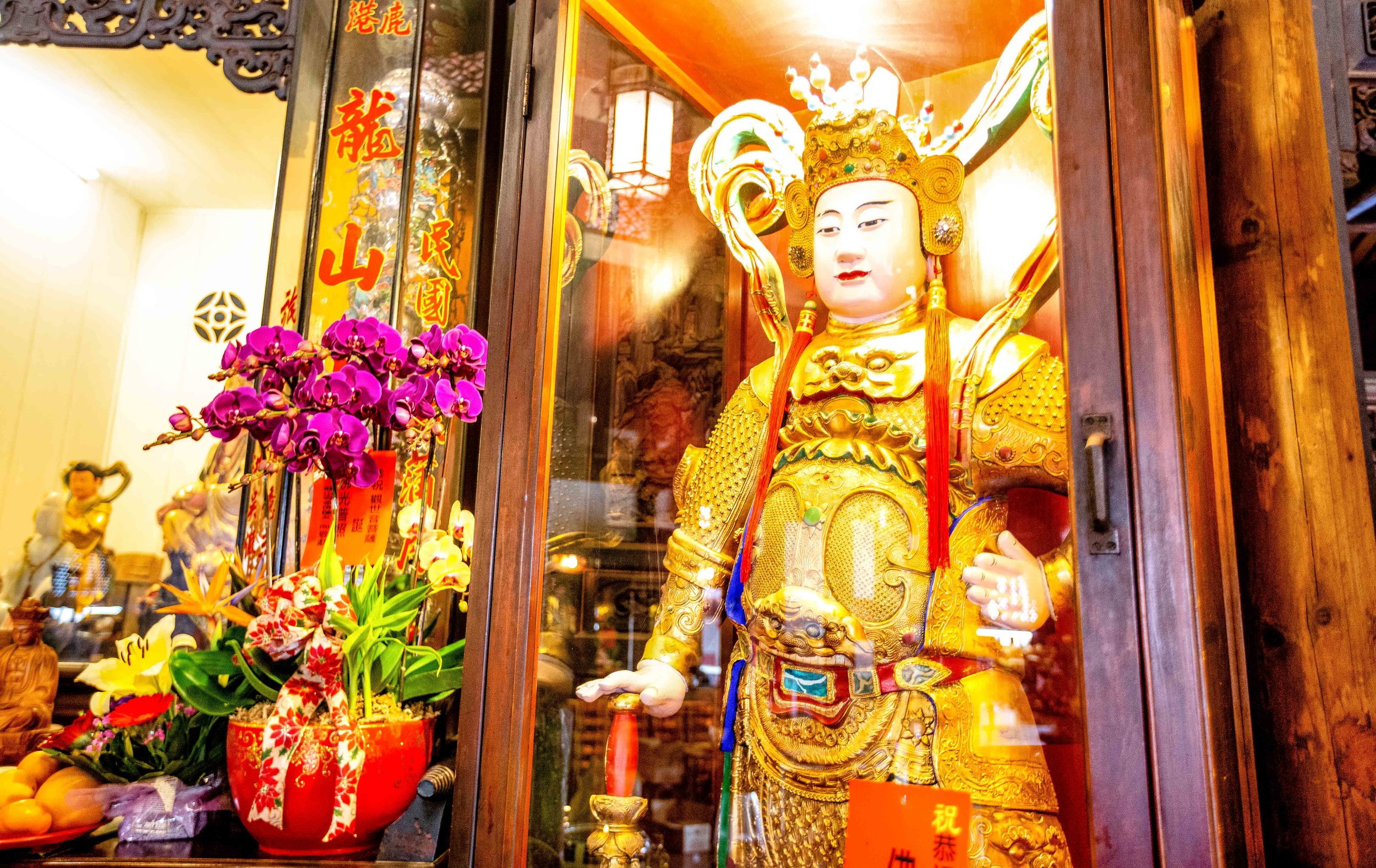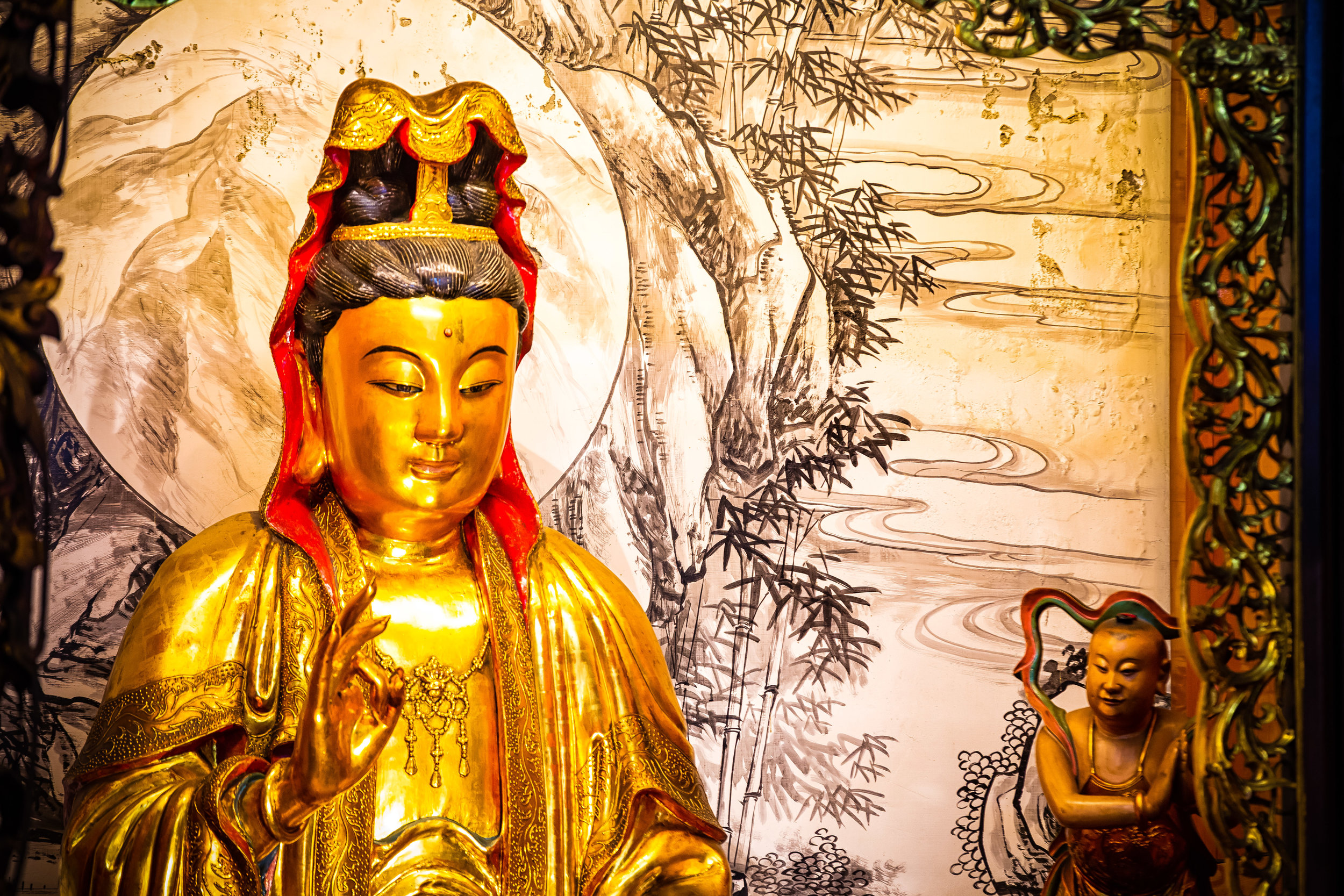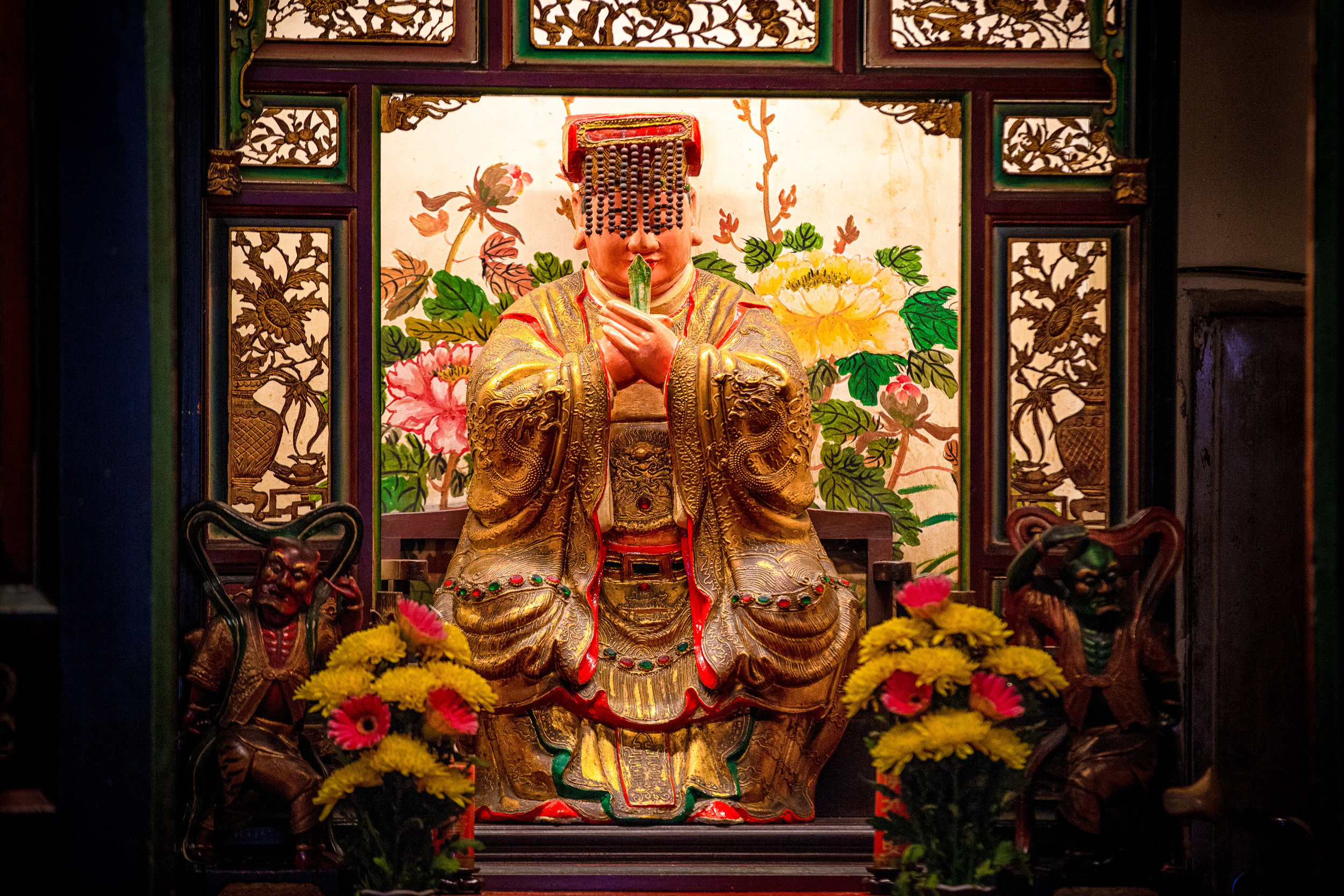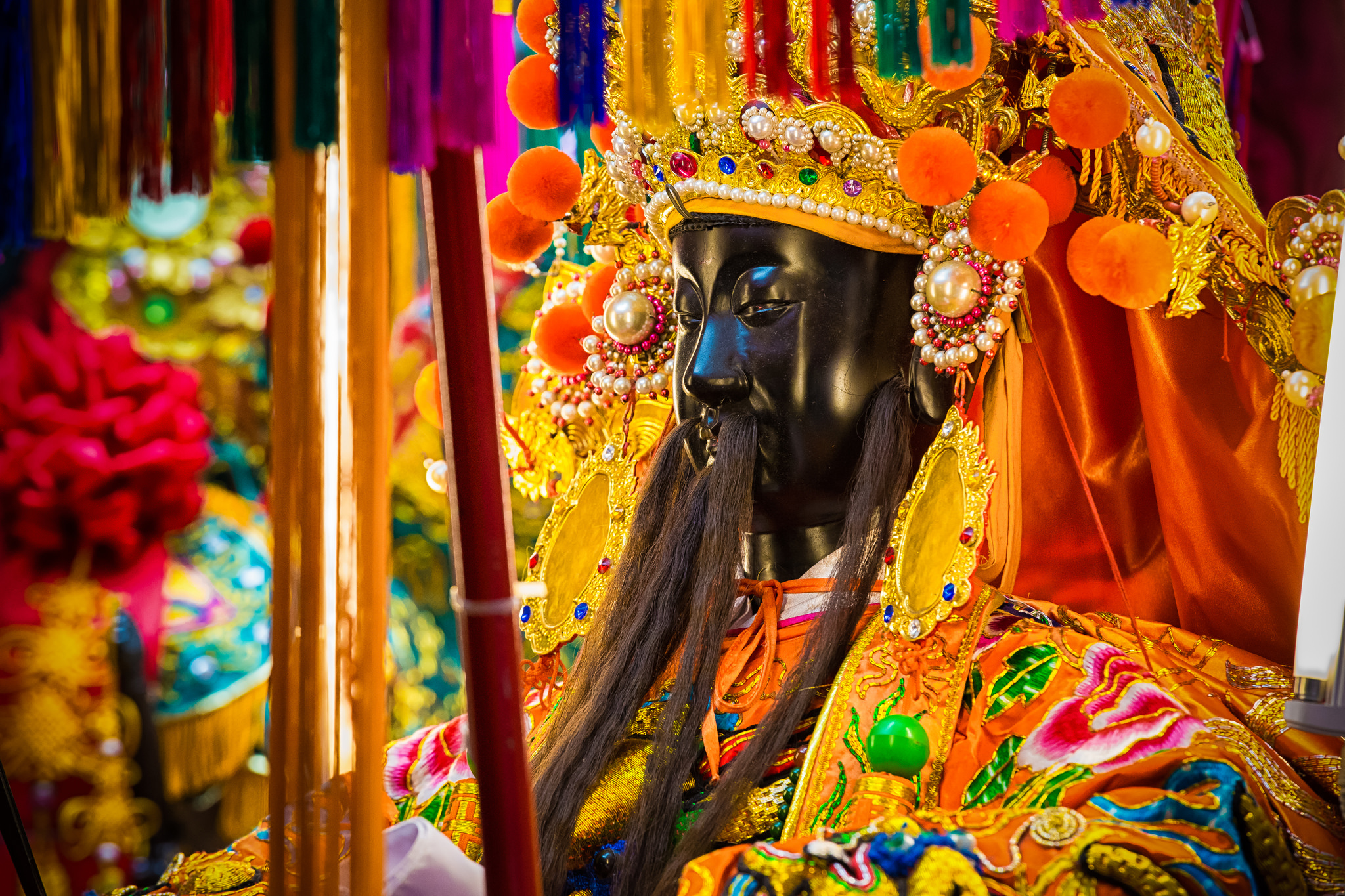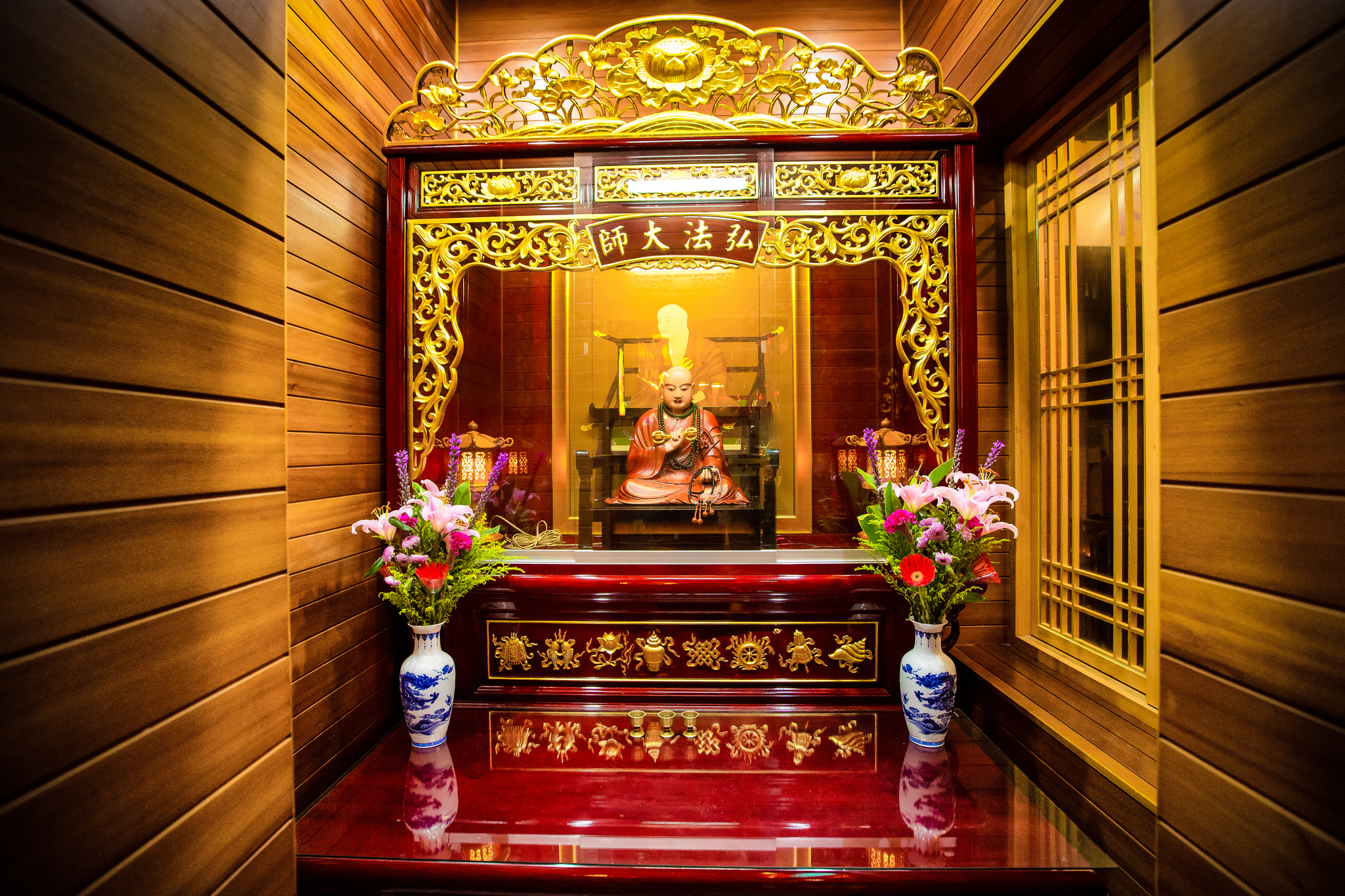When planning a trip to Taiwan, one of the stops that is always high on the list of places to visit is Taipei’s historic Longshan Temple - and for good reason - the bustling temple in the city’s historic Wanhua District (萬華區) offers tourists a first-hand experience with the vibrancy of Taiwanese religion, culture and the traditional architecture that is considered ‘exotic’ by a lot of foreign visitors.
What though do those tourists who are able to invest a bit more time exploring Taiwan do?
Well, they get out of Taipei and head south - Then they visit the ‘other’ Longshan Temple.
Yes, there is more than one Longshan Temple. (There are a handful of them actually)
Taipei’s Longshan Temple tends to be the busiest of the lot, but that is really only because it is conveniently located within the capital and is easily accessible thanks to the amazing MRT system. Don’t get me wrong, it is an amazing place to visit - I’ve been there a hundred times and I’ll probably go a hundred more times.
But, (yes, there is a but) Taiwan’s first “Longshan Temple”, the most historic of the group, not only stands out as one of the most attractive of the bunch - it is also regarded as one of the most beautiful temples in the whole of Taiwan as well as one of the best remaining examples of a building constructed during the Qing dynasty with traditional Fujian-style architecture.
Located in the historic village of Lukang (鹿港), the temple is just one of the many amazing destinations the small coastal village has to offer. Needless to say, if you haven’t heard of Lukang, you really should take some time to check it out. What might seem a small village in the middle of no where is actually an action packed day trip with some of the coolest historic sites you’re going to see in Taiwan. This is why it has become such a popular destination for both domestic and foreign tourists alike. Lukang is a village that has been frozen in time and provides visitors with an amazing snapshot of what the Taiwan of olde was like.
Longshan Temples of Taiwan
The Longshan Temples of Taiwan have a history that is directly related to the early migration of Hokkien Chinese settlers from China’s Fujian Province (福建省). Starting in the early 1600’s, due to the political instability of the Ming Dynasty (明朝), many people hailing from the Fujian and Guangdong (廣東省) areas made the decision to emigrate across the Taiwan strait and throughout various parts of South East Asia.
In Taiwan’s case, the Hokkien people sought to make a go of it in what was a very under-developed land bringing with them only their language, culture, cuisine and folk religion as well as what little possessions they could fit on the boat.
The original Longshan Temple, constructed during the Tang Dynasty (唐朝) somewhere between 618-619, received its name thanks to its location on “Longshan” (龍山) or Dragon Mountain in Anhai, Fujian.
The original, like every other ‘Longshan Temple’ that followed is dedicated to the Buddha of Compassion, whom in the Chinese Buddhist tradition takes the form of Guanyin (觀音菩薩), a female Buddha.
Non-Chinese Buddhists are likely more familiar with Tibet’s Buddha of Compassion who appears in human form as the Dalai Lama.
Here in Taiwan, the tradition that these temples would be dedicated to Guanyin has continued, but as the centuries have passed they started to accommodate Taoist and local folk-religion deities as well - many of whom also happen to hail from the Fujian region.
Even though you can now find several deities housed within Taiwan’s various Longshan Temples, the fact remains that essence of religious worship that takes place within is rooted in Chinese Zen Buddhist tradition.
Something that I can’t underscore enough about the religious experience in Taiwan compared to the west is that temples here have the ability to house gods from what are considered to be ‘different’ religions yet there are never any problems that arise from this. The religious experience here is one of tolerance and should certainly act as a model for those around the world who would use their beliefs to cause harm to others.
Today there are five temples in Taiwan with histories that date between 160 - 370 years which were all constructed during the Qing dynasty.
Lugang Longshan Temple (鹿港龍山寺) - 1647
Tainan Longshan Temple (台南龍山寺) - 1715
Monga Longshan Temple (艋舺龍山寺) - 1738
Fengshan Longshan Temple (鳳山龍山寺) - 1765
Tamsui Longshan Temple (淡水龍山寺) - 1858
Daxi Longshan Temple (大溪龍山寺) - 1868
Each of the temples differs in its design, but they all share a similar history and purpose making the Longshan Temple’s of Taiwan an important place of worship and of course, historical value.
Lukang Longshan Temple (鹿港龍山寺)
The oldest of all of the Longshan Temple’s in Taiwan is located in Changhua County’s Lukang Village - With a history that is said to date back to 1647. and is considered to be one of the most historic in all of Taiwan.
Something I’ve learned over the past few years though is to take some of these historical “facts” with a grain of salt.
Does the Lukang Longshan Temple in fact date back to 1647? Technically yes and technically no.
The history of a ‘Longshan Temple’ in the area most certainly dates back to the mid-1600s. However that history doesn’t necessarily relate to building that we see today. The original was actually a much smaller shrine, in another part of the village and was constructed solely to house a statue of Guanyin that was brought to Taiwan from the original Longshan Temple.
The temple we see today moved to its current location in 1786 and since then has been expanded upon, renovated and restored on several different occasions with reconstructions in the 1800s forming the basis of the structure that we continue to enjoy today.
So, while it may not be as old as advertised, Its still quite old.
History
To make things a bit clearer, I’ve gone ahead and translated some of the more important historical events over the temple’s long history:
1647 - Immigrants from Quanzhou (泉州) bring a statue of Guanyin from the original Longshan Temple in Fujian on the voyage across the Taiwan strait and set up a small shrine on what is now a small alley near Dayou Street (大有街).
1786 - The original shrine moves to its current location across town on a larger plot of land.
1798 - After only a decade the newly constructed temple turns out to be far too popular and needs to be expanded to accommodate the amount of people who visit. The expansion sets in stone (literally) the layout for the temple which confines the complex to the 5,300 square meter plot of land that we still see today.
1897 - Two years after the Japanese Colonial Era began, the Japanese authorities rented out the rear hall of the temple to create a Pure Land Buddhist (浄土仏教) shrine to accommodate Japanese Buddhists who lived in the area. Part of the temple is also used as a school for teaching the Japanese language to the local people.
1904 - The temple joins a network of Pure Land Temples (淨土真宗本願寺派 / じょうどしんしゅうほんがんじは) and the Guanyin statue is relocated to the Rear Hall and replaced with a statue of Amida (阿彌陀佛) in the Main Hall.
1921 - In what would become one of the worst tragedies in Lukang history, a fire completely destroys the Rear Hall of the temple taking with it the historic statue of Guanyin.
1938 - Reconstruction of the Rear Hall is completed.
1961 - Sixteen years after the Japanese Colonial Era ended, it is decided that the Main Shrine of the temple would revert back to Guanyin and the statue of Amida would be moved to the Rear Hall.
1983 - The temple is awarded the designation as a ‘First Class National Historic Site’ (國家第一級古蹟) making it a protected historic building.
1999 - On September 21st the powerful Jiji Earthquake (集集大地震) rocked Taiwan and created mass destruction all over the country. The temple was badly damaged as a result of the quake, so another massive reconstruction project is started to repair the damage.
2002 - Reconstruction project is completed.
2005 - Josh visits for the first time and falls in love (with the temple).
Design
When most people talk about the Lukang Longshan Temple, they only briefly mention the temple’s long history - Numbers are thrown out and people nod their heads and think “cool”, because when it comes to this temple, its not its age that really matters.
This temple is often described as one of the best remaining examples of Southern Fujian Qing-style architecture remaining in Taiwan. Does the average tourist really understand what any of that means though?
When you walk around the temple you don’t really have to really understand the complexities of historic architecture to realize that this temple is a masterpiece of design.
Interestingly though, whenever you search for “Southern Fujian Architecture” or “Hokkien Architecture” (閩南風格) most of the search results will feature a photo of the temple as the prime example of the characteristics of this style of architecture.
Hokkien-style architecture shares many similarities with other styles of Chinese architecture but there are of course several different ways that make buildings constructed in this style distinctive from others. First, the material used to construct this style of building is usually a mixture of red brick and wood. For most commoners in China, the usage of the colour red was frowned upon because “red” was typically reserved for imperial buildings. The Hokkien people it seems didn’t really care much about that though.
Another important characteristic is the “Swallowtail Roof” (燕尾脊) which refers to having a roof with an ‘upward-curving ridge’ shaped like the tail of a swallow. This design tends to vary in terms of the degree of the curve as well the number of layers on the roof but is something quite common throughout Taiwan.
Finally, to compliment the swallowtail roof designs, the Hokkien style often includes colourful porcelain carvings (剪瓷雕) which became common not only on the roofs of temples but also homes and ancestral shrines as well. The porcelain designs range from plants and animals to mystical creatures from Chinese mythology including dragons and phoenixes.
As one of the most well-preserved temples of its kind, the Lukang Longshan Temple combines all three of these architectural designs with beautiful red brick, swallowtail designed roofs on the main halls and gates and expertly crafted porcelain figures decorating the buildings.
The temple also follows the traditional ‘Three-Hall-Two-Courtyard’ design (三進二院) which refers to the three halls - The Front Hall (五門殿), Main Hall (正殿) and the Rear Hall (後殿) which are separated by the front courtyard and the rear courtyard and surrounded by passage ways on the perimeter of the building.
If you take a look at the diagram above, you may discover that the temple is constructed to resemble the Chinese Character “日“ which translates into English as either “sun” or “day”.
You could easily spend hours of your day enjoying the minutia and intricate designs of this temple, so I hope the following descriptions of each section helps to point out some of the things that you should pay close attention to when you visit.
Even if you can’t read Mandarin, I recommend checking out this site to see some historic photos of the temple as well as some sketches that beautifully illustrate the layout of the temple.
The Main Gate (山門)
The Main Gate of the temple, often referred to as the “Mountain Gate” (山門) is one of the most impressive you’ll see in Taiwan. The courtyard in front of the gate is decorated with red lanterns that lead up to the beautifully constructed wooden gate. Between the layers on the roof is a plaque that reads “Longshan Temple” (龍山寺). There are also red lanterns hanging off of the layer below that read “Lukang Longshan Temple” (鹿港龍山寺).
Not only is the gate held up on the front end by wooden pillars, it is also connected to a brick base that forms the entrance and also part of the wall that surrounds the entire perimeter of the temple.
The Main Gate is not only impressive from a distance but when you get close enough you can easily see the mastery it took to design such an intricate roof with the pillars holding the gate up.
Before entering the temple make sure to take some time to stand under the gate looking up at the beautiful work and all of its intricate pieces.
Paper Incinerator (惜字塔)
In the front square before you enter the temple quietly sits a relic of the past that isn’t widely talked about in English-language articles. What looks like a simple brick tower is actually a paper-burning incinerator that is of cultural and historic significance.
To describe it simply, Taiwan is a very humid place which makes it easy for things (like paper) to rot or become moldy. Before we had dehumidifiers and air conditioners people had little recourse to preserve the books they had, so as a show of respect for the written word, when people finished reading something they wouldn’t just leave it around. Likewise, throwing books in the garbage was simply not an option, so they took the book to an incinerator like this one and burnt it so that the words would live on in eternity.
I know, it sounds weird, right?
This practice was especially common with the Hakka people of Taiwan who constructed these special furnaces in the areas where they lived. As time went on, these towers became more and more unnecessary, so in many places around the country they’ve unfortunately been torn down.
In recent years however there has been a push to preserve them as they are of cultural and historical significance. In Taoyuan for example two of these incinerators, which are known as “Miracle Terraces” (聖蹟亭) have been restored and are open to the public as cultural shrines.
The paper incinerator at the temple looks like it hasn’t been in use for decades and sits quietly in a corner, still though, most people, including locals walk by it and don’t pay it any attention despite its historic significance.
Front Hall (五門殿)
The “Front Hall” is a actually a very simplistic term for what the main entrance of the temple actually is; In Chinese, the name translates directly as the “Five Door Hall” and is sometimes referred to as the “Five Door Portal”. No matter how you like to translate the name of the Front Hall, it consists of five doors with the three in the middle separated by four stone pillars.
Directly in front of the centre-most door is an incense cauldron with beautifully carved calligraphy on it.
On either side of the cauldron are stone pillars that have a dragon encircling the column.
On the walls you’ll find traditionally carved windows that are made out of wood and allow for the natural flow of air through the gate. On the windows you’ll find various designs including dragons, tigers, phoenixes which together symbolize prosperity and longevity.
On the interior it is important to pay attention to the ‘Door Gods’ (門神) that are painted on the doors.
When the doors are open they will face the inside of the temple and when the temple closes at night they’ll face the exterior. The ‘Door Gods’ have somewhat faded over the years but this style of artwork has started to become something of a lost art in Taiwan, so its great that we can still enjoy these.
The Door Gods on the main door in the centre represent Skanda (韋馱), the guardian of Buddhist Monasteries as well as Sangharama (伽藍), the Buddhist name for popular historical figure known as Guan Yu who is highly regarded for his ability to offer spiritual protection and grant blessings. The remaining four doors each have one of the Four Heavenly Kings (四大天王) who bestow wealth, success, peace and protection.
Theatre Pavilion (戲殿)
The ‘Theatre Pavilion’ is traditionally an area where temple performances would take place.
Temples constructed in Taiwan within the last century have (for the most part) constructed their performance stages in a separate area from the rest of the temple, usually outside of the main gates. This has allowed for larger, more mobile stages and more space for the audience, while reducing the amount of noise within the temple.
Truthfully, in all my years of temple hopping I can only count a handful of times where the Theatre Pavilion was actually constructed in such a central location in the temple.
Once you enter the Front Hall, the Theatre Pavilion is a large flat space with a spider-web caisson decorating the ceiling above it.
Few performances are held in this area anymore but the open space it provides in addition to the caisson above make it an especially grand spot that you won’t find at many other temples in Taiwan.
The Caisson (八卦藻井)
While doing research for this post I learned a new word - I’ve never actually known the English word for these so-called ‘spider web ceilings’ but whenever I see them I’m absolutely amazed by them.
In the case of this temple, the “caisson” is jaw-droppingly beautiful. There are so many adjectives that could be used to describe how beautiful the craftsmanship on this ceiling is but I’m at a loss for words - and if you have the chance to see it, I’m sure you will be too.
Known as the most beautiful “caisson” (藻井) in all of Taiwan, the “Ba-Gua ceiling” as I’d prefer to call it is an architectural masterpiece found in many East Asian temples and palaces. The reason I call it a “Ba-Gua” ceiling is because it is octagonal, a shape that has particular significance in local folk religion and culture.
Note: Bagua (八卦) refers to eight symbols in Taoism that represent the fundamental principles of reality and are interrelated with each other. At the centre of the Bagua is the Yin-Yang symbol. (Wikipedia link)
This particular caisson was constricted during the temple’s 1831 reconstruction and there are claims that it is one of the oldest of its kind in Taiwan.
A caisson is basically a sunken layered panel in a ceiling that raises above the rest of the ceiling almost as if there were a dome above it. The layers of the caisson are often beautifully decorated and with a design at the centre - in this case a beautifully painted dragon.
The most amazing thing about these caisson’s is that they are designed using expertly measured interlocking pieces that go together in a way that mean that neither beams nor nails are used to keep them together.
They just lock together to form a six-layer deep spider-web of beauty.
The Ba-Gua ceiling here commands respect and has become one of the most defining features of the temple. If you are visiting, I can’t stress it enough that you need to spend a few minutes with your head in the air appreciating the beauty and genius of this architectural masterpiece.
Worship Hall (拜殿)
To make a bit of a comparison, the Worship Hall at the temple is similar to something like the front patio of a house - It is more or less just a large covered platform that allows people to perform religious rituals without actually entering the Main Hall.
On the left and right side of the Worship hall sit a couple of century-year old trees that offer a bit of shade in front of the hall. Likewise each side of the hall has a station that allows people to light candles and incense for their prayers. In the centre there is another large incense cauldron with beautiful calligraphy carved on it. Behind the cauldron sits a large table where people can place offerings and is where you’ll often find beautiful floral decorations donated by visitors to the temple.
Of note when it comes to the design are the two stone dragon columns on either side of the incense cauldron - The columns which date back to 1852 are each carved with a dragon encircling the pillar. The dragons each have a pearl in their mouth and one in their foot while showing their fangs. The way the dragons encircle the columns make them is said to make them almost lifelike as they seem like they’re constantly in motion.
On the back of each column you’ll find the same four creatures featured in the windows of the Front Hall - A Phoenix (鳳), Qilin (麟), Crane (鶴) and Turtle (龜) - known as the ‘four spirit animals’ and together represent an idiom in Chinese (鳳毛麟趾、鶴算龜齡) that is really hard to translate to English but more or less refers to the rarity of the animals, how precious they are and the longevity of their lifespans (稀奇珍貴、祥瑞長壽) - certainly a metaphor for the temple.
Also of note are the two octagonal passageways on either side of the Worship Hall that lead to the the rear area of the temple. The passageways have become quite popular with photographers, especially wedding photographers who you might run into while touring the temple.
If you visit the temple make sure to take a few photos from the two doors as they’ve become quite iconic.
Main Hall (正殿)
To start, the roof of the Main Hall is actually quite simple; Following the same design as the other sections, the roof is a double-layered swallowtail design. On each of the tips you’ll find a dragon that is facing a pagoda in the middle.
Interestingly the Door Gods at the Main Hall mirror those of the Front Hall and consisting of the Four Heavenly Kings (四天大王), Skanda (韋馱), and Sangharama (伽藍). This time however they are painted a bit differently representing different aspects of their character. In this case they appear more ‘compassionate’ and ‘scholarly’ while they appear a bit more threatening on the outside.
Note: The scary, threatening Door Gods are considered to be “martial” (武) representations while the compassionate representations are considered ‘scholarly’ (文).
The interior of the hall is really where the design of the temple really shines - It is dark, not very well-lit and constructed with a network of stained wooden beams that hold everything up.
In the centre of the building, the ceiling rises almost a level higher than at the entrance - On the sides there are windows on both the east and west ends that allow for natural light to flow into the building offering a bit more light on the inside.
On the far right of the shrine room you’ll find statues dedicated to the Eighteen Arhats (十八羅漢), the original disciples of the Buddha. Next to them you’ll see desks nearby where there are attendants watching over the building and are there to answer any questions you may have.
The main shrine consists of several different statues of Guanyin, the Buddha of Compassion.
The largest statue is a replacement for the original that was brought to Taiwan in the 1600s. Accompanying the large image of Guanyin are several others which were carved out of wood or molded out of bronze.
Once again, to the direct left of the main shrine you’ll find martial representations of Sangharama (伽藍) and to the right Skanda (韋馱) whose purpose is to act as spiritual bodyguards for Guanyin.
You’ll also find a shrine dedicated to the Goddess of Childbirth (註生娘娘), The Monkey King (齊天大聖) and the Dragon King (龍王).
Rear Hall (後殿)
The Rear Hall of the temple is considered the youngest part of the entire complex due to the fact that it had to be rebuilt after a fire destroyed the original hall.
The new version of the hall dates back to 1938, during the Japanese Colonial Era and its design us a reflection of the era with a mixture of both Japanese and Chinese styles.
The exterior of the hall is a simple one that follows the Hokkien style of design making using of the swallowtail roof. The doors and the interior however are constructed completely of Taiwanese Cyprus and the Stone Dragon Columns are more ‘Japanese’ in design than the columns in the previous two halls.
To the sides of the Rear Hall you’ll find two round doors which used to be the dorm rooms for the temple abbot. Today the room to the right has been converted into a kitchen and the room on the left is partly used for storage and also allows guests to go to visit the back garden or the public restrooms.
On the doors of the Rear Hall you will find General’s Heng and Ha (哼哈二軍) who are mythical generals that date back to the Shang Dynasty (商朝). They’re mostly known today in their capacity as ‘Door Gods’ at Buddhist Temples.
Like the exterior, the interior of the hall is very simple in design with shrines dedicated to various Buddhist figures. In front of the shrines there is ample floor space that allows for the nuns who hold daily prayer services to take a seat on the floor.
In fact, the main reason why I don’t have many photos of the interior of the Rear Hall is due to one of the daily prayer services taking place at the same time of my visit. Even though I missed out on getting better photos of shrines inside, I did enjoy taking photos of the ladies who were busy chanting.
As mentioned above, the Rear Hall is home to several Buddhist figures which include Amida (阿彌陀佛), Sakyamuni Buddha (释迦牟尼) and the Medicine Buddha (藥師佛) - known as the ‘Three Treasures’ (三寶佛).
You’ll also find statues of Manjusri (文殊菩薩), Puxian (普賢菩薩), Jizo (地藏王菩薩), the Wind God (風神), Rain God (雨神), the God of Literature (文昌帝君) and the Zhenwu Emperor (玄天上帝).
Last but not least in the courtyard in front of the Rear Hall you’ll find an old well known as the “Dragon Stream Well” (龍泉井) which used to be where the people who lived and worked at the temple got their water. Today the well is closed up but you can still see that there is water inside.
Getting There
Lukang isn’t particularly a large town and is easily walkable - If you arrive in a car or on a scooter the best thing you can do is just find a parking space walk around to better explore the magic of the historic village.
Home to several historic temples, buildings, businesses as well as an old street were you can sample local delicacies, there is certainly more than enough to do while you’re in Lukang and if you plan your day well enough you should be able to explore for an entire day (or more if you have the time).
If you get tired of walking there are bicycle rental vendors all over the city - I’d recommend saving yourself some money and getting a Youbike instead.
Lukang doesn’t have its own railway station, so if you want to visit using public transportation you have a few different options:
Take a Ubus direct to the village from Taipei Bus Station ($350NT).
Take a bus from Taichung - You can choose either Bus #6936 from Taichung HSR Station or Bus #6933 from Taichung Railway Station.
Take a bus from Changhua - From the Changhua Railway Station you’ll find buses that frequently travel back and forth. (Buses: 6900, 6901, 6902, 6909, 6933, 6934, 6936 - Website)
Take a scenic ride with a YouBike from Changhua Train Station on the six kilometre ride to Lukang - There are stations all over Changhua City as well as in Lukang to get a bike. Make sure to download the YouBike App so you’ll know where to get a bike.
Whatever method you choose to get to the village, I can’t stress it enough that once you’re there you should walk around and enjoy the quiet ambience of one of Taiwan’s most historic villages. You’ll easily be able to walk through the village and see all of the most important sites without needing a car or a scooter.
The Lukang Longshan Temple is located at “No. 81, Jinmen Street” (彰化縣鹿港鎮金門街81號) and is open to the public and to tourists everyday from 6:00am - 9:00pm.
Okay, so this post turned out much longer than I actually expected - And I really only scratched the surface when it comes to the history and design - You could write a thesis about this place and you still wouldn’t come close to describing all of the fine details.
I suppose it is arguable whether or not Lukang‘s Longshan Temple is factually one of the “oldest” temples in Taiwan, it is however the oldest “Longshan Temple” in the country and when it comes to its beauty, it really does stand out as one of the most stunning places of worship in Taiwan. Its age and adherence to traditional architectural styles place it very high on the list of the most important historic temples to visit and I can assure you that if you do have the chance to go, you’ll certainly be glad you did.
Visiting Taipei’s Longshan Temple is obviously much more convenient for the majority of people who travel to Taiwan, but if you’re one of those people who takes a little bit of extra time to explore the country, a visit to Lukang and the many historic temples within the small village should be high on your list of things to do.




